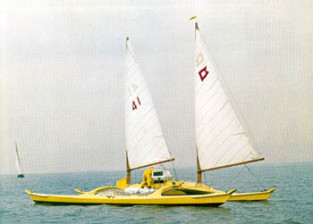Given the popularity of the Madness study plans (surprise!) I'm assured I'm not the only person geeking for more accounts of what it's like sailing her. So I wonder if John might indulge in a little "proacrastination" (thanks for the term, John) for the benefit of those potentially proaplanning for possible proacreation.
How have you found the boat to behave in heavier conditions, especially with sloppy seas? Critics assert "that looks awfully wet," but I always say "the whole ocean is quite wet, after all." Is there anything you'd change in the shape to keep her drier? I ask since I've noticed A bit more flare in the sections of Russell Brown's proas near the ends and wondered if that was a seakeeping feature that might have been somewhat sacrificed for simplicity?
That said, it certainly looks like a drier boat than something like Newick's Atlantic proa Cheers, whose ends by contrast look so insubstantial...by the way, was that screaming yellow color choice just a coincidence or a conscious homage?
I love the way Madness looks: such a wonderfully simple, elemental form graced with very pretty sheerlines. My dad, who as a catamaran builder was convinced one of these things would need aluminum crossbeams, is now eagerly looking at those drawings of how you accomplished them in composite wood/epoxy/carbon. I think it's the first time he's really been taken aback by what you describe as the light construction possible with this architecture.
One other thing I'm curious about is the initial assembly. Is it actually done the same way, for example, as a little kayak, i.e two 30-odd foot pieces wired together to make the boat up to the chine...no strongback, just popping in pre-located bulkheads and forms when you open the two halves?
Please know how much of a stir of enthusiasm and appreciation you all have caused with this boat: those of us who've worked from CLC plans in the past couldn't be more thrilled that you've decided to bring this kind of innovation to the amatuer builder.
